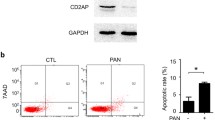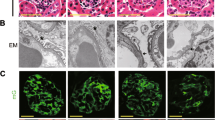Summary
Eukaryotic expression vectors carrying the small hairpin RNA (shRNA) for TRPC6 mRNA were constructed, and the effects of knocking-down TRPC6 on puromycin aminonucleoside (PAN)-induced apoptosis of mouse podocytes were observed. Two eukaryotic expression vectors containing small hairpin structure targeting TRPC6 named pGCsi-TRPC6A and pGCsi-TRPC6B were designed and synthesized. The plasmids were transfected into conditionally immortalized murine podocyte cell line by liposome. The changes in the TRPC6 mRNA and protein expression were observed by RT-PCR and Western blot after 48 h. Cultured podocytes were divided into four groups: control group, PAN treatment group, PAN treatment+shRNA transfection group, and PAN treatment+ negative control group. The expression of Bax and Bcl-2 mRNA and proteins was detected by RT-PCR and Western-blot respectively. The apoptotic rate of podocytes was measured by flow cytometry. The results showed that the expression of TRPC6 mRNA and protein was decreased in the podocytes when transfected with pGCsi-TRPC6A, and pGCsi-TRPC6B. The expression of Bax was increased, and that of Bcl-2 was decreased at protein and mRNA levels in the podocytes after treated with PAN for 48 h. These changes was attenuated by knocking-down TRPC6. Knocking-down TRPC6 could effectively decrease the PAN-induced apoptosis of podocytes. It was concluded that TRPC6 may play an important role in the PAN-induced apoptosis of podocytes. Knocking-down TRPC6 gene could effectively prevent the podocytes from apoptosis induced by PAN.
Similar content being viewed by others
References
Shankland SJ. Cell cycle regulatory proteins in glomerular disease. Kidney Int, 1999,56(4):1208–1215
Ziyadeh FN, Wolf G. Pathogenesis of the podocytopathy and proteinuria in diabetic glomerulopathy. Curr Diabetes Rev, 2008,4(1):39–45
Hara M, Yanagihara T, Kihara I, et al. Apical cell membranes are shed into urine from injured podocytes: a novel phenomenon of podocyte injury. J Am Soc Nephrol, 2005,16(2):408–416
Kriz W, Gretz N, Lemley KV, et al. Progression of glomerular diseases: Is the podocyte the culprit? Kidney Int, 1998,54(3):687–697
Winn MP, Conlon PJ, Lynn KL, et al. A mutation in the TRPC6 cation channel causes familial focal segmental glomerulosclerosis. Science, 2005,308(5729):1801–1804
Reiser J, Polu KR, Moller CC, et al. TRPC6 is a glomerular slit diaphragm-associated channel required for normal renal function. Nat Genet, 2005,37(7):739–744
Moller CC, Wei C, Altintas MM, et al. Induction of TRPC6 channel in acquired forms of proteinuric kidney disease. J Am Soc Nephrol, 2007,18(1):29–36
Mundel P, Reiser J, Zuniga Mejia Borja A, et al. Rearrangements of the cytoskeleton and cell contacts induce process formation during differentiation of conditionally immortalized mouse podocyte cell lines. Exp Cell Res, 1997,236(1):248–258
Jiang HJ, Chang Y, Zhu ZH, et al. Role of CD2-associated protein in podocyte differentiation. Sheng Li Xue Bao (Chinese), 2008,25(1):135–142
Zhang C, Jiang HJ, Chang Y, et al. Downregulation of CD2-associated protein impaired the physiological functions of podocytes. Cell Biol Int, 2009,33(6):632–639
Kobayashi N, Kriz W. Introduction to the podocyte issue: more than eight enigmas. Microsc Res Tech, 2002,57(4):187–188
Schlondorff JS, Pollak MR. TRPC6 in glomerular health and disease: What we know and what we believe. Semin Cell Dev Biol, 2006,17(6):667–674
Mukerji N, Damodaran TV, Winn MP. TRPC6 and FSGS: the latest TRP channelopathy. Biochim Biophys Acta, 2007,1772(8):859–868
Brummelkamp TR, Bemards R, Agami R, et al. A system for stable expression of short interfering RNAi in mammalian cells. Science, 2002,296(5567):550–553
Sharp PA, Zamore PD. RNA interference. Science, 2000,287(5462):2431–2433
Elbashir SM, Harborth J, Lendeckel W, et al. Duplexes of 21 nucleotide RNAs mediate RNA interference in cultured mammalian cells. Nature, 2001,411(6836):494–498
Kim YH, Goyal M, Kurnit D, et al. Podocyte depletion and glomerulosclerosis have a direct relationship in the PAN-treated rat. Kidney Int, 2002,60(3):957–968
Zheng CX, Chen ZH, Zeng CH, et al. Triptolide protects podocytes from puromycin aminonucleoside induced injury in vivo and in vitro. Kidney Int, 2008,74(5):596–612
Wada T, Pippin JW, Marshall CB, et al. Dexamethasone prevents podocyte apoptosis induced by puromycin aminonucleoside: Role of p53 and Bcl-2-related family proteins. J Am Soc Nephrol, 2005,16(9):2615–2625
Liu SF, Ding J, Fan QF, et al. Establishment of a podocyte cell injury model induced by puromycin aminonucleoside. Beijing Da Xue Xue Bao (Chinese), 2008, 40(6):586–589
Szegezdi E, Macdonald DC, Ní Chonghaile T, et al. Bcl-2 family on guard at the ER. Am J Physiol Cell Physiol, 2009,296(5):941–953
Schiffer M, Bitzer M, Roberts IS, et al. Apoptosis in podocytes induced by TGF-beta and Smad7. J Clin Invest, 2001,108(6):807–816
Wada T, Pippin JW, Terada Y, et al. The cyclin-dependent kinase inhibitor p21 is required for TGF-beta1-induced podocyte apoptosis. Kidney Int, 2005,68(4):1618–1629
Ding G, Reddy K, Kapasi AA, et al. Angiotensin II induces apoptosis in rat glomerular epithelial cells. Am J Physiol Renal Physiol, 2002,283(1):173–180
Author information
Authors and Affiliations
Corresponding author
Additional information
This project was supported by grants from the National Natural Science Foundation of China (No. 30500245 and No. 30871174) and the Science Research Foundation of Health Department of Hubei Province (No. NX200510).
Rights and permissions
About this article
Cite this article
Sun, X., Fang, Z., Zhu, Z. et al. Effect of down-regulation of TRPC6 on the puromycin aminonucleoside-induced apoptosis of mouse podocytes. J. Huazhong Univ. Sci. Technol. [Med. Sci.] 29, 417–422 (2009). https://doi.org/10.1007/s11596-009-0405-9
Received:
Published:
Issue Date:
DOI: https://doi.org/10.1007/s11596-009-0405-9




